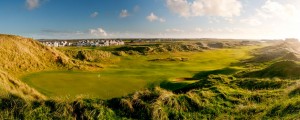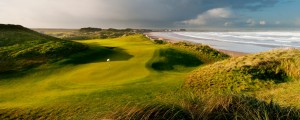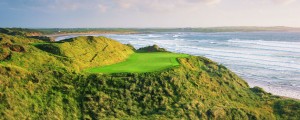Doonbeg Course Review
Personally, I find there’s always a degree of anxiety when it comes to playing golf on a links course. This has nothing to do with the set up of the course itself or a lack of confidence in my “bump-and-run”, but more a fear of appearing cowardly. For no matter how hurricane-like the winds or how horizontal the rain, you really cannot refuse to play on account of the weather.
To duck out because of a gale force wind (or a “stiff breeze” as I’m sure the locals would call it) is to admit weakness, and is certain to earn a lifetime of chastisement, and quite rightly, as the wind is a links course’s first line of defence, factored in to the designer’s every angle, hump and hollow. Presented with totally benign conditions and an ocean resembling a mill pond, many links courses give you the opportunity to go out and shoot a good score. Your absent friends will admire your ‘taming of a beast’ but you’ll know that the day you played the tiger had had its claws clipped and was taking a nap.
 Links golf is all about the wind and, certainly at Doonbeg, there’s every chance you’ll have to deal with a rolling Atlantic breeze that has the potential to wreak havoc with your scorecard. And so that proved when I played it quite recently. Seeing the 45 degree angle of the pins I was under no illusions this was a day for scoring, but I’d come to play links golf and, ignoring my shaking knees, I wasn’t going to show any cowardice…..
Links golf is all about the wind and, certainly at Doonbeg, there’s every chance you’ll have to deal with a rolling Atlantic breeze that has the potential to wreak havoc with your scorecard. And so that proved when I played it quite recently. Seeing the 45 degree angle of the pins I was under no illusions this was a day for scoring, but I’d come to play links golf and, ignoring my shaking knees, I wasn’t going to show any cowardice…..
The magnificent links at Doonbeg sits proudly at the western tip of County Clare and is truly open to all the Atlantic elements. The difficulty writing a review of the course is that I doubt any one day is the same as another, given the vagaries of the weather, so I’ll avoid describing par 5s as ‘reachable’ or a par four as ‘short’. You play what you’re presented with on the day, and if that means hitting your driver on a 150 yard Par 3, so be it. This, though, is part of the unmistakable beauty of playing at Doonbeg. What satisfaction it must afford the members, living in the knowledge that they’re playing a different golf course each time they tee it up.
Doonbeg is a relatively new course, having been designed by Greg Norman and opened for play in 2002. Like all modern links courses, a pre-requisite of the design was its sympathetic treatment of the natural environment, and the results are simply breathtaking. This is a truly natural golf course that feels as though it has been here as long as the dunes themselves. So blessed were they with the land that Norman’s vision included fourteen of Doonbeg’s greens and twelve of its fairways simply being mown on the existing land, without a bulldozer in sight.
On a layout that essentially heads away from the dramatic clubhouse for the first nine holes, and returns on the back, the variety of directions in which the holes play is extremely clever. The wind will rarely change direction during the course of your round, but you’ll have to contest with winds that blow from every direction, given the angle of the holes. This is a true test of control and shotmaking.
Outward Nine
The first hole, played grandly from a raised tee, is a long straight par five heading out parallel with the beach towards rising dunes in the distance. You’ll need to be accurate here to avoid one or two sand traps, but it is an opportunity for a positive start. Halfway down the second and you’ve lost the clubhouse, swallowed by the dunes behind, leaving you to concentrate on the task at hand. And it’ll need your full attention as you play to the split level green on this treacherous par four. The key to this hole really is in finding the right level of the green; otherwise an incredibly difficult putt remains.
 The third, a par four, meanders slightly uphill towards a greenside property with surrounding stone walls. This wall is certainly in play, and it encroaches perilously close to the right hand side of the raised green. A sneaky hole, and one that looks unthreatening, but I suspect it harvests its fair share of ruinous scores.
The third, a par four, meanders slightly uphill towards a greenside property with surrounding stone walls. This wall is certainly in play, and it encroaches perilously close to the right hand side of the raised green. A sneaky hole, and one that looks unthreatening, but I suspect it harvests its fair share of ruinous scores.
The par five fourth feels like an opportunity. The fairway feels reasonably inviting, and seems to gently fade away with the contours of the land. But even if conditions don’t allow the longer hitters to get home in two, it’s a comfortable lay up for all. The green may have a few subtle breaks, but a few birdie chances will certainly be yielded here.
The fifth turns a corner and demands a fine straight drive up the hill to the crest of the fairway. The reward is a stunning view as you aim your second over a gully and out towards the green with a backdrop of the rugged Atlantic shoreline. The par four sixth may not be the longest but it’s one of the most undulating on the course. This, combined with the long narrow green, makes clubbing important, and a prudent choice off the tee may be well advised.
The seventh is fairly straight forward but can be long, and is played towards a green sheltered by imposing dunes behind. The other side of these dunes is the tee for the next hole, a slight dog leg left par five. It’s a long hole where most of the attention is required on the lay-up, which can be very narrow, and the subsequent pitch on to the green.
The short par three ninth is fabulous. Played adjacent to the fencing that marks the boundary between beach and golf course, it’s a strong par three that requires decisive play on a bold line. With any left to right wind, you can literally be aiming out of bounds in order to hit the green. Be bold and keep your head down!
Inward Nine
Homeward bound, and the tenth plays diagonally away from the coastline, which if you’ve been taking a gale force battering for the past half dozen holes, can come as welcome respite. It’s a fine par five that punishes the timid and rewards the brave. The best line in is from the left side of the fairway, which flirts with out of bounds the nearer to the green you get. Miss on the right however, and you leave a devilish up and down to make a score.
At around 150 yards long, you could be forgiven for thinking the eleventh hole is there for the taking, but whilst a green found with the tee shot will give an opportunity for birdie, anything slightly careless will leave a buried grassy lie and a tough chip.
Doubtless, the twelfth hole will provide a talking point: it boasts the unusual feature of having a bunker in the middle of the green. This will, of course, draw criticism from certain quarters (doubtless those who had to circumnavigate with their putter) but for my money it simply challenges our preconceived ideas of a golf hole. When a quirk occurs on an ‘old fashioned’ layout, it’s considered part of the charm, or a defining master stroke of design that “you don’t see nowadays”. Yet when something novel is introduced on a new course, it is quickly passed off as a gimmick. In reality, the twelfth hole at Doonbeg is just an example of how modern golf course design confronts the orthodox.
 The thirteenth is a great par five, climbing steeply as it dog-legs to the right. Most of the trouble is in the approach shot here, with steep banks, numerous bunkers, thick rough, and of course the wind to negotiate. It leads perfectly into the signature 14th hole, merely 100 yards long but perhaps one of the most daunting on the course. Famed for its dramatic drop-offs and the lethal punishment that awaits any misplaced shot, it can play from the shortest flick with an iron, to a full blooded shot with a fairway wood. In short, the challenge is to hit the green or rack up a number. Whatever you walk away with, the fourteenth will be a favourite for many visitors, and it’s easy to see why.
The thirteenth is a great par five, climbing steeply as it dog-legs to the right. Most of the trouble is in the approach shot here, with steep banks, numerous bunkers, thick rough, and of course the wind to negotiate. It leads perfectly into the signature 14th hole, merely 100 yards long but perhaps one of the most daunting on the course. Famed for its dramatic drop-offs and the lethal punishment that awaits any misplaced shot, it can play from the shortest flick with an iron, to a full blooded shot with a fairway wood. In short, the challenge is to hit the green or rack up a number. Whatever you walk away with, the fourteenth will be a favourite for many visitors, and it’s easy to see why.
Fifteen is a strong par four where the fairway rolls away from right to left. Trying to keep it on this fairway is tough, as is the second shot up towards a rising green that can hide the flag behind tall grass in the foreground. Playing the par three sixteenth, it’s evident the pin placement will dramatically influence how the hole will play. The green is 40 yards deep, so choice of club is the key to success.
By the time you get to seventeen, you feel like you’re rounding the corner for home as the clubhouse and hotel come into view again. With thick rough sweeping down the left side, it’s easy to bail out too far right on the tee shot. But with ample bunkers to gobble up your ball, it’s another that requires a bold play for a chance of par.
The final hole is a stern test. Played with the beach in full view on your right, it requires two strong shots. The second is played from an undulating fairway to an expansive green in front of the hotel. You’ll need to home in on a target more specific than just the green however, to earn a satisfying finish on your scorecard.
The Resort
The comforts of the hotel at Doonbeg wait just off the eighteenth, and while the accommodation, restaurant, spa, and general service are clearly exquisite, there is another option for those staying on site that I would thoroughly recommend. Located opposite the seventeenth fairway, the self-catering Lodges are simply stunning. Large, luxurious, and with boundless comforts and character, it’s impossible not to feel completely relaxed from the moment you walk in the door. They’ll accommodate a couple or a large group, and everything in between.
The lodge’s facilities are exceptional but should the atmosphere, food and beverages at nearby Darby’s bar prove too enticing to ignore, you won’t be disappointed.
 When you reflect on playing golf a new course for the first time, more often than not I find two or three holes come to mind that brought particular enjoyment. Not necessarily holes played well, but holes that captured the imagination. Arguably, it’s where the phrase ‘Signature Hole’ comes from, when the collective opinion establishes a particular hole as the one. Very occasionally, you might be fortunate enough to play a world class golf course where all eighteen live long in the memory. Retiring to the Lodge at Doonbeg, with time to reflect on the day’s play as the Atlantic wind murmured down through the chimney, it occurred to me that Doonbeg is definitely in that latter category – here there are eighteen gloriously individual and memorable holes, complemented by facilities you’d expect of a truly world class resort. What a combination.
When you reflect on playing golf a new course for the first time, more often than not I find two or three holes come to mind that brought particular enjoyment. Not necessarily holes played well, but holes that captured the imagination. Arguably, it’s where the phrase ‘Signature Hole’ comes from, when the collective opinion establishes a particular hole as the one. Very occasionally, you might be fortunate enough to play a world class golf course where all eighteen live long in the memory. Retiring to the Lodge at Doonbeg, with time to reflect on the day’s play as the Atlantic wind murmured down through the chimney, it occurred to me that Doonbeg is definitely in that latter category – here there are eighteen gloriously individual and memorable holes, complemented by facilities you’d expect of a truly world class resort. What a combination.
……………
Doonbeg is in County Clare, Ireland and provides the perfect base for a tour of Ireland’s West Coast links, including the exceptional courses of Tralee, Lahinch, Ballybunion and Waterville.